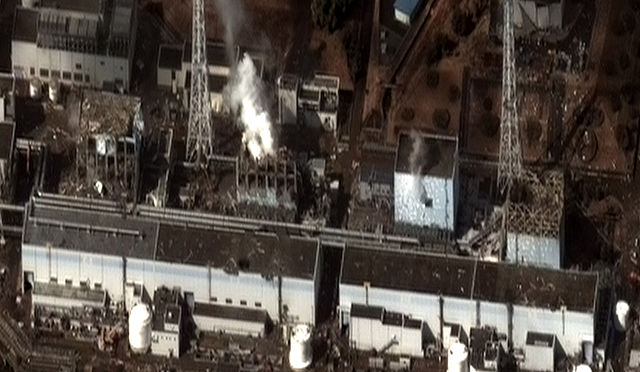Fukushima nuclear accident
The Fukushima nuclear accident was a major nuclear accident at the Fukushima Daiichi nuclear power plant in Ōkuma, Fukushima, Japan which began on March 11, 2011. The proximate cause of the accident was the 2011 Tōhoku earthquake and tsunami, which resulted in electrical grid failure and damaged nearly all of the power plant's backup energy sources. The subsequent inability to sufficiently cool reactors after shutdown compromised containment and resulted in the release of radioactive contaminants into the surrounding environment. The accident was rated seven on the INES by NISA, following a report by the JNES. It is regarded as the worst nuclear incident since the Chernobyl disaster in 1986, which was also rated a seven on the INES.
The four damaged reactor buildings (from left: Units 4, 3, 2, and 1) on 16 March 2011. Hydrogen-air explosions in Units 1, 3, and 4 caused structural damage.
Aerial view of the station in 1975, showing separation between units 5 and 6, and 1–4. Unit 6, completed in 1979, is seen under construction.
Unit 3 after the explosion on 15 March 2011.
The unit 4 reactor building after the explosion. The yellow object is the reactor's removed PCV head. The removed black RPV head with its lifting frame attached is to the left. Both had been removed to allow refueling at the time. The green gantry crane carries fuel between the RPV and the spent fuel pool.
Nuclear and radiation accidents and incidents
A nuclear and radiation accident is defined by the International Atomic Energy Agency (IAEA) as "an event that has led to significant consequences to people, the environment or the facility." Examples include lethal effects to individuals, large radioactivity release to the environment, or a reactor core melt. The prime example of a "major nuclear accident" is one in which a reactor core is damaged and significant amounts of radioactive isotopes are released, such as in the Chernobyl disaster in 1986 and Fukushima nuclear disaster in 2011.
Following the 2011 Japanese Fukushima nuclear disaster, authorities shut down the nation's 54 nuclear power plants. The Fukushima site remains radioactive, with some 30,000 evacuees still living in temporary housing, although nobody has died or is expected to die from radiation effects. The difficult cleanup job will take 40 or more years, and cost tens of billions of dollars.
The Kashiwazaki-Kariwa Nuclear Power Plant, a Japanese nuclear plant with seven units, the largest single nuclear power station in the world, was completely shut down for 21 months following an earthquake in 2007. Safety-critical systems were found to be undamaged by the earthquake.
The abandoned city of Pripyat, Ukraine, following the Chernobyl disaster. The Chernobyl nuclear power plant is in the background.
Dr. Joseph G. Hamilton was the primary researcher for the human plutonium experiments done at U.C. San Francisco from 1944 to 1947. Hamilton wrote a memo in 1950 discouraging further human experiments because the AEC would be left open "to considerable criticism" since the experiments as proposed had "a little of the Buchenwald touch."







